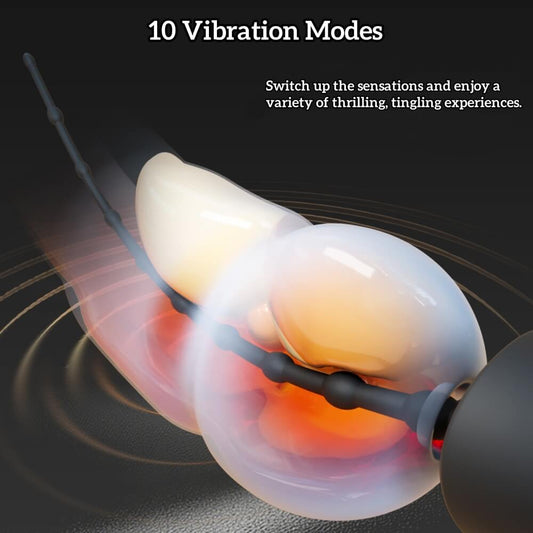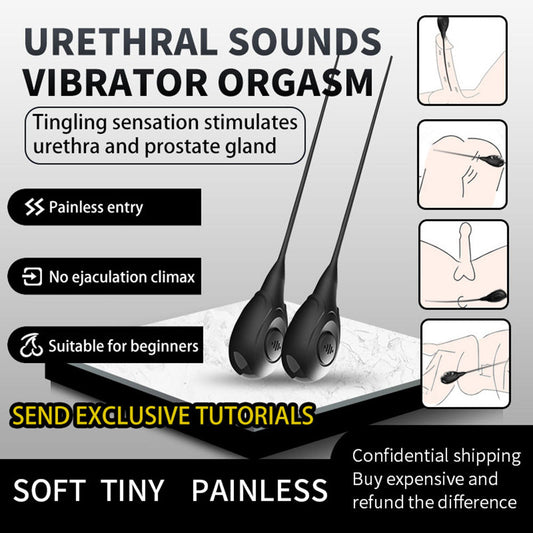Urethral sounding—often called “sounding”—is one of those intimate kinks that most people hear about long before they actually understand it. It involves inserting a smooth, medical-style rod into the urethra, and while that might sound intimidating, many people swear by the unique sensations it can provide. But this is not something to jump into blindly. To stay safe and enjoy the experience, it’s crucial to understand how sounding works, what to expect, and how to prepare properly.
What Is Urethral Sounding?
Sounding started as a medical practice used to treat strictures or clear blockages in the urethra. Over time, some people discovered that the sensation of insertion and deep pressure could be highly erotic. The urethra contains sensitive nerve endings and, in men, passes directly through the prostate—the body’s natural “pleasure button.” When performed safely, sounding can provide deep internal stimulation that feels unlike any other form of play.

Why People Try It
People try urethral sounding for different reasons:
-
Curiosity: The idea of stimulating an internal passageway is intriguing and taboo.
-
Heightened Sensation: The urethra is lined with delicate nerves that can create tingling, full-body pleasure.
-
Prostate Access: For men, deep sounding can directly stimulate the prostate from inside the body.
-
Couples Play: Sounding can build trust and intimacy when done carefully with a partner.
While the potential for pleasure is real, sounding requires patience, cleanliness, and respect for your body’s limits. Done carelessly, it can cause pain, bleeding, or infection.
Safety First: Preparing for Sounding
Sounding isn’t inherently dangerous, but it’s not risk-free either. The key is sterility and control. Here’s how to prepare properly:
1. Choose the Right Material
Beginners should start with stainless steel sounds, not silicone.
Steel is non-porous, easy to sterilize, and slides smoothly with lube. Silicone rods tend to create friction and can be difficult to insert safely. A simple Hegar sound set (5–7 mm) is often ideal for new users.
2. Sterilize Everything
Even a microscopic bit of bacteria can cause a urinary tract infection (UTI).
Before each session:

-
Boil your sound in water for a few minutes or soak it in medical-grade disinfectant.
-
Wash your hands thoroughly and consider wearing sterile nitrile gloves.
-
Use a sterile, single-use water-based lube—not regular personal lube from an open bottle.
Avoid oil-based or silicone lubes unless they specifically say they are safe for internal use.
3. Set the Scene
Clean your play area, dim the lights, and get comfortable. Sounding works best when you’re relaxed and unhurried. Many prefer to start while flaccid, especially for their first few attempts.
Shop The Best Sounding Rods From Anesidora
Featured Products
Black Beaded Urethral Vibrator
$29.99 USD
Sale price
$26.99 USD
Anesidora Vibrating Urethral Sound Rod
$32.99 USD
Sale price
$29.69 USD
Silicone Vibrating Sounding Rod Penis Trainer
$39.99 USD
Sale price
$35.99 USD
Stainless Steel Beaded Sounding Rod
$19.99 USD
Sale price
From $17.99 USD
How to Insert a Sounding Rod
Patience is everything. Here’s a simple step-by-step guide:
-
Apply Lube Generously: Coat both the sound and the urethral opening. You can also draw a bit of lube into a small sterile syringe and inject a few drops directly into the urethra.

-
Position Yourself: Sit, recline, or stand—whatever gives you steady control.
-
Start Gently: Place the tip of the rod at your urethral opening and let gravity and your breathing do the work. Don’t push. The sound should slide in smoothly on its own.
-
Pause When You Feel Pressure: If you encounter resistance, stop immediately. Forcing it can tear the delicate lining of your urethra.
-
Breathe and Relax: Sometimes adjusting your angle or taking a few deep breaths allows the muscles to loosen and the sound to move deeper.
If it doesn’t go in easily, withdraw slowly, add more lube, and try again another day.
During the Experience
Once the sound is inside, you can experiment a little—very gently. Try shallow in-and-out motions or small rotations. Some people enjoy lightly stroking the penis externally at the same time, which can heighten the sensations.
If you plan to go deeper, remember: the further you insert, the greater the risk of hitting the bladder sphincter or delicate tissues. Deep sounding should only be attempted after months of gradual practice and full familiarity with your body.
Pain, burning, or resistance are red flags. Pleasure should feel like pressure, warmth, or fullness—not sharp or searing pain.
Aftercare: Cleaning and Recovery
When you’re ready to finish:
-
Slowly withdraw the sound while keeping it lubricated.
-
Urinate afterward. This helps flush out any bacteria or residue that might have entered. It might sting briefly, which is normal.
-
Clean your genitals and the sound with warm water and mild, unscented soap.
-
Sterilize the sound again before storage.
Drink plenty of water to keep your urinary system clear. If you notice ongoing pain, blood in the urine, or burning that lasts more than a day, see a healthcare provider—ideally one familiar with kink-related practices.

Common Mistakes to Avoid
Many sounding injuries happen because of rushed or uninformed play. Avoid these common pitfalls:
-
Using random objects. Never insert household items like straws, pens, or paintbrushes. Only use medical-grade toys designed for urethral use.
-
Skipping sterilization. Even clean-looking toys can harbor bacteria.
-
Starting too small or too big. Begin with mid-size sounds (5–7 mm). Tiny ones can puncture the urethra; oversized ones can tear it.
-
Reusing lube containers. Dipping a used sound back into a bottle introduces contamination.
-
Sharing toys. Never use the same sound on multiple people.
Remember: infection and injury are far more likely when safety steps are ignored.
Tips for Beginners
If you’re new to sounding, take it slow. Here are some beginner-friendly guidelines:
-
Go one size at a time. Don’t jump from 5 mm to 10 mm overnight.
-
Stay flaccid at first. It’s easier to control the rod and avoid friction.
-
Don’t sound too often. Give your urethra time to heal—wait several days between sessions.
-
Stay hydrated. Peeing often keeps things flushed and reduces the risk of infection.
The first few sessions may feel awkward or mildly uncomfortable. Over time, you’ll learn what kind of pressure and depth feel pleasurable versus what feels wrong.
Advanced Sounding and Prostate Play
For some experienced users, sounding becomes a gateway to prostate stimulation. When inserted deep enough, a sound can press directly against the prostate from the inside, creating deep, full-body orgasms. However, this “deep sounding” carries extra risk and should only be attempted once you’ve mastered the basics. Many enthusiasts work up to this over months of gradual training and increased comfort with longer rods.
Always remember: pleasure should never come at the cost of injury. Stop immediately if you feel pain, and consult a kink-aware or urology professional before exploring more advanced techniques.

Hygiene, Consent, and Mindset
Sounding is as much about trust as it is about sensation. If you’re playing with a partner, set clear boundaries and establish safe words. Both partners should understand sterile technique and communicate throughout.
Sounding can be deeply erotic, but it also requires a calm, mindful approach. You’re exploring one of the most delicate parts of your body. Treat it with respect, and it can become a uniquely powerful form of pleasure.
Final Thoughts
Sounding isn’t for everyone—but for those who take the time to learn, it can open a new world of erotic exploration. The key is safety, patience, and self-awareness. Start small, stay clean, and listen to your body.
When done responsibly, urethral sounding isn’t just about shock value; it’s about discovering new sensations, deepening intimacy, and exploring the hidden pathways of pleasure.






